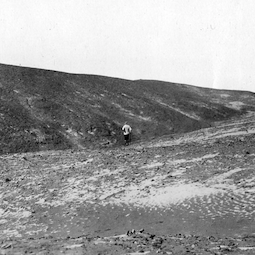Tell Bandar (Mound V)
Tell Bandar ("the harbour mound" in Arabic) is a small, U-shaped tell visible from the top of Tell Ingharra's large ziggurat. It hides a fortress and a tower from the Parthian period. Also called "Mound V" by archaeologists, it has a long history of occupation, dating back to the Early Dynastic period, or early third millennium BCE (Moorey 1978: 30).
 [/kish/images/tellbandar-fig1-large.jpg]
[/kish/images/tellbandar-fig1-large.jpg]1. "Ruins of Tell Bandar", undated. Source: OFME Photo Album, ANT 140, p. 95 (no negative number)
Tell Bandar was explored by the French Assyriologist Julius Oppert, who carried out a small excavation at the site in 1852. Because all this expedition's finds were lost in the river Tigris at Qurna, early on the journey back to Paris, no information survives about finds made at the time. But Tell Bandar continued to attract the attention of archaeologists in later years.
In 1879, the Iraqi archaeologist and antiquities dealer Daoud Thoma excavated Tell Uhaimir and Tell Ingharra for a year on behalf of Hormuzd Rassam and the British Museum, assisted by twenty other men (Gibson 1972: 68). He also explored Tell Bandar. Because Hormuzd Rassam did not report any results from Daoud's excavation at Tell Bandar in his publications, it is assumed that little was found (Gibson 1972: 68). But this might not be the case since Daoud began to sell large collections of cuneiform tablets from at least 1884. When the American Orientalist William Hayes Ward visited Tell Bandar in 1885 during the "Wolfe Expedition to Babylonia", he reported that the trenches left by Daoud were still visible, though some may have been those left by Oppert.
The French Assyriologist Henri de Genouillac also explored Tell Bandar in 1912. He and his team discovered the tower of a fortress on the north-eastern corner of the tell, with part of a long wall which stretched to the west and a semi-circular bastion. He noted that the fortress had two particular features: narrow loopholes in the walls of the upper floor, and false columns in the walls of the lower floor.
In 1933, Watelin exposed the whole northern end of the fortress and the tower's south-east corner for the OFME. He also remarked on these features, and reported that the Parthian architects had used earlier buildings as foundations (Moorey 1978: 30). The most renowned objects discovered at Tell Bandar are Parthian figurines made of baked clay, and "magical" incantation bowls found on the surface of the mound (Moorey 1978: 30).
15 Sep 2025
Nadia Aït Saïd-Ghanem
Nadia Aït Saïd-Ghanem, 'Tell Bandar (Mound V)', The Forgotten City of Kish • مدينة كيش المنسية, The Kish Project, 2025 [http://oracc.org/MoundsofKish/TellBandar/]